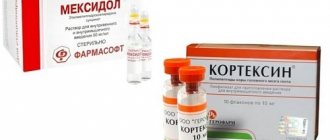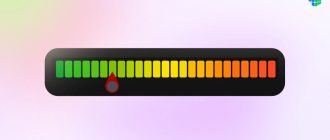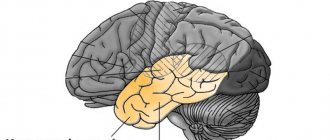Deterioration of memory, attention, and sleep problems are often associated with impaired cerebral circulation, due to which cells do not receive enough oxygen. For the prevention and treatment of such disorders, the effective drug Mexidol is used. It is available in the form of tablets and solution, which can be purchased with a doctor's prescription.
Mexidol tablets: indications for use
Mexidol instructions recommend use for:
- consequences of acute cerebrovascular accidents, including after transient ischemic attacks, in the subcompensation phase as preventive courses;
- mild traumatic brain injury, consequences of traumatic brain injury;
- encephalopathies of various origins (dyscirculatory, dysmetabolic, post-traumatic, mixed);
- autonomic dystonia syndrome;
- mild cognitive disorders of atherosclerotic origin;
- anxiety disorders in neurotic and neurosis-like conditions;
- coronary heart disease as part of complex therapy;
- relief of withdrawal syndrome in alcoholism with a predominance of neurosis-like and vegetative-vascular disorders, post-withdrawal disorders;
- conditions after acute intoxication with antipsychotic drugs;
- asthenic conditions, as well as for the prevention of the development of somatic diseases under the influence of extreme factors and stress;
- exposure to extreme (stress) factors.
Mexidol injections: indications for use
Mexidol has a wide range of therapeutic effects. The drug is prescribed by narcologists, neurologists, psychiatrists, therapists and other doctors. Main indications:
- Acute or chronic diseases characterized by insufficient blood flow to the brain.
- Traumatic, metabolic or toxic damage to the central nervous system. The drug is also used at the rehabilitation stage.
- Autonomic nervous system disorder. Mexidol is prescribed for vegetative-vascular dystonia.
- Treatment of cognitive complications of atherosclerotic brain damage, accompanied by decreased memory and intelligence.
- Acute disruption of blood flow to the heart muscle. Restoration of the cardiovascular system after a heart attack.
- Chronic cardiac ischemia. Used as an addition to main therapy.
- Mental illnesses of the neurotic spectrum, manifested by anxiety, sleep disturbances and decreased mood.
- Consequences of the effects of alcohol, antipsychotics and other substances on the brain. The medicine relieves withdrawal symptoms.
- Acute inflammatory or infectious processes in the abdominal cavity. Prescribed together with other medications.
Mexidol is also used to prevent the development of somatic and mental illnesses if a person is exposed to chronic stress.
Mexidol analogues are cheaper (list with prices)
In pharmacies you can find many foreign and domestic cheap analogs of Mexidol, sold both in tablets and ampoules.
Popular analogues according to composition and principle of effect on the body are listed below, indicating the average price:
- Mexicor – 230 rubles;
- Meksifin – 240 rubles;
- Mexiprim - 355 rubles;
- Astrox – 310 rubles;
- Neurox – 355 rubles;
- Cerecard – 240 rubles;
- Medomexi – 220 rubles.
There are also drugs that have different chemical compositions with Mexidol, but the same principle of action on the body.
Such cheap analogues of Mexidol, produced in tablets and ampoules, include:
- Actovegin – 1020 rubles;
- Glycine – 95 rubles;
- Nootropil – 280 rubles;
- Instenon – 265 rubles;
- Cortexin – 920 rubles;
- Cavinton – 360 rubles;
- Mildronate – 445 rubles.
Why are injections prescribed?
Mexidol (5 or 2 ml) is useful for blood vessels. During the period of use, there is a restoration of blood flow in the affected tissues and an increase in the elasticity of the walls. If a patient is given injections (2 ml) for psycho-emotional disorders, the antidepressant effect is characterized by:
- reducing the severity of morphological and dystrophic disorders in the brain;
- memory improvement;
- improving learning ability;
- restoring sleep;
- relief of signs of psychogenic type pathologies;
- restoration of behavioral reactions.
Mexidol can be administered to patients in a withdrawal state. The syndrome develops after alcohol abuse. The benefit of the drug is due to its ability to have a beneficial effect on the functioning of the brain. Mexidol injections are prescribed for asthenic syndrome, helps with blood pressure and treats neuroses. For prevention, the medication is prescribed to relieve the symptoms of certain somatic pathologies. Main indications for use:
- intoxication caused by taking psychotropic drugs;
- post-withdrawal and pseudoneurotic disorders caused by systematic abuse of alcoholic beverages;
- ischemia;
- constant feeling of anxiety;
- encephalopathy caused by post-traumatic or dyscirculatory disorders;
- traumatic brain injuries;
- acute circulatory disorders in the brain.
The use of the drug is possible for vegetative-vascular dystonia.
Mexiprim or Mexidol – which is better to buy?
Mexiprim is another high-quality and inexpensive substitute for Mexidol, sold in tablet and injection form.
The analogue, like the original, is based on ethylmethylhydroxypyridine succinate. One tablet contains 125 mg of the active substance, and 1 ml of solution contains 50 mg.
Both the analogue and the original drug have the same indications for use:
- neuroses;
- vegetative-vascular dystonia;
- consequences of stress;
- alcohol poisoning;
- deterioration of memory and concentration;
- cognitive problems.
Mexiprim should not be used if:
- liver and kidney pathologies;
- intolerance to the components of the drug;
- children under 18 years of age;
- pregnancy and breastfeeding.
Mexiprim is usually well accepted by the body. In rare cases, the patient experiences drowsiness, nausea, an allergic reaction, and dryness of the oral mucosa.
As you can see, the analogue and the original are exactly the same in composition, release form, and principle of effect on the body. The advantage of Mexiprim over Mexidol is its more affordable price.
Indications for the use of intramuscular injections
The instructions for using Mexidol say that the injection solution is used in the treatment of open-angle glaucoma of various stages, in case of acute myocardial infarction (from the first day Mexidol is connected to a complex therapy regimen). For purulent-inflammatory processes of the abdominal organs, acute inflammation of the pancreas, necrotizing pancreatitis or peritonitis, injections are especially effective. The following is a more detailed list of indications for the use of Mexidol injections:
- acute cerebrovascular accidents;
- traumatic brain injury, consequences of traumatic brain injury;
- encephalopathy;
- autonomic dystonia syndrome;
- mild cognitive disorders of atherosclerotic origin;
- anxiety disorders in neurotic and neurosis-like conditions;
- acute myocardial infarction (from the first day) as part of complex therapy;
- primary open-angle glaucoma of various stages, as part of complex therapy;
- relief of withdrawal syndrome in alcoholism with a predominance of neurosis-like and vegetative-vascular disorders;
- acute intoxication with antipsychotic drugs;
- acute purulent-inflammatory processes of the abdominal cavity (acute necrotizing pancreatitis, peritonitis) as part of complex therapy.
The best analogues in ampoules
Mexidol substitutes, which are available in ampoules, according to some studies, are considered more effective. Of these, the most commonly used are Mexifin, Neurox, Cerecard, Cortexin and Cytoflavin.
Mexicofin
Meksifin is an antioxidant agent that has an effect similar to Mexidol. The drug inhibits the peroxidation of radicals and activates enzymes involved in the repair of cell wall membranes:
- enhances aerobic glycolysis;
- improves cerebral circulation and microcirculation;
- stimulates the immune system;
- increases the rheological properties of blood;
- reduces platelet aggregation;
- may reduce the toxic effects of alcohol.
General information about the drug Mexifin
It has the same indications for use as Mexidol: vegetative-vascular dystonia, peripheral circulatory disorders. It has an antiatherogenic effect, due to which it is prescribed for atherosclerotic changes in blood vessels. Mexifin is taken 50 mg twice a day, if necessary, increase the dose, but not more than 300 mg per day. The drug may cause nausea and drowsiness.
Neurox
Neurox is an anxiotic, anticonvulsant drug. It is used for drug therapy of neurocirculatory dystonia, neuroses and neurosis-like conditions, acute phase of infarction, open-angle glaucoma, traumatic brain injury, anxiety disorders, peripheral blood supply disorders, intoxication with antipsychotic drugs.
Effect of Neurox on the body
May cause sleep disturbances, flatulence, nausea, discomfort in the cardiac region, and inspiratory shortness of breath. Method of administration: intravenous; it is recommended to administer it in a stream over 6 minutes. Do not use simultaneously with antiepileptic and antiparkinsonian drugs and benzodiazepine anxiolics.
Cerecard
Cerecard is produced in the form of a solution for injection (in ampoules). It is quickly absorbed when taken orally (after 40 minutes), distributed throughout the tissues and excreted after 7 hours. It is excreted by the formation of metabolites in the liver and excreted in the urine. The drug is indicated for:
- encephalopathies;
- atherosclerotic lesions;
- disorders of the blood supply to the brain;
- coronary heart disease.
Contraindicated during pregnancy, lactation, liver or kidney failure and in childhood. Dosage of Cerecard depending on the pathology:
| Disease | Dosage per day |
| Encephalopathy | 0.1 g |
| Mild cognitive impairment | 0.1-0.3 g |
| Cerebral blood flow disorders | 0.2-0.3 g |
| Purulent-inflammatory processes | from 0.3 to 0.5 g |
| Neurotic conditions and neuroses | from 0.05 to 0.1 g |
Cortexin
Cortexin is a psychostimulant belonging to the group of nootropics. The drug consists of a complex of polypeptide fractions, which complicates its pharmacological analysis, as well as interaction with other drugs.
It has tissue-specific, antioxidant, neuroprotective and nootropic effects. The mechanism of action is due to the activation of neurotrophic factors and peptides of nerve cells. It is strictly prohibited to use the medication without a doctor's prescription.
Mechanism of action of Cortexin
Cortexin is used in therapy:
- traumatic brain injuries;
- cerebral circulation disorders;
- cognitive disorders.
The contents of the bottle are dissolved in 1-2 ml of water for injection and administered intramuscularly. Rarely, it may cause adverse reactions such as hypersensitivity, nausea, rash, fever.
Cytoflavin
Cytoflavin is a complex of various active ingredients: nicotinamide, riboflavin sodium phosphate, succinic acid and riboxin. Used only in adults to treat the consequences of cerebrovascular disorders and myocardial infarction.
It is administered intravenously in a bolus, diluted with 100 ml of 5% glucose solution. The dose of Cytoflavin depends on the disease:
- for myocardial infarction, use 15 ml of the drug;
- for cerebral infarction – 10 ml.
Indications for use
May cause the following side effects:
- psychomotor agitation;
- dyspnea;
- metallic taste;
- rashes of various shapes and localization;
- scabies;
- increase in daily diuresis;
- weakness;
- hyperthermia;
- tachycardia;
- sensitivity disorders;
- pale skin;
- difficulty breathing;
- dry cough;
- dry mouth;
- transient hypoglycemia;
- pain in the epigastric region.
For cervical osteochondrosis
Being an inhibitor of free radical processes, Mexidol provides a powerful antioxidant effect. The drug will also help in cases where it is necessary to remove half-life products of degenerative and dystrophic processes in the vertebrae. This effect of the drug is especially relevant for the treatment of osteochondrosis of the lumbar region, where inflammatory, dystrophic and degenerative processes are most severe. In the case of treating the cervical spine, the drug is useful because it has an antihypoxic effect. Simply put, it increases tissue resistance to oxygen deficiency.
Initially, a dosage of no more than 100 mg of the drug is prescribed 1-3 times a day.
If the effect is noticeable in the first two days, then this dosage is maintained throughout the entire course of treatment. If there is no effect or it is barely noticeable, the dosage is gradually increased until a therapeutic effect is achieved.
This is especially true, since such a deficiency often occurs against the background of cervical osteochondrosis. In this case, the posterior parts of the brain are affected, which manifests itself as dizziness and impaired coordination of movements. Mexidol has a certain effectiveness in terms of improving cognitive functions (memory, attentiveness, speed of decision-making). This is also useful for osteochondrosis, since these functions are affected in most patients (if the cervical spine is affected).
For headaches
Mexidol is a medicine produced by a Russian pharmaceutical company. The main purpose of the medicine is to restore blood circulation to the brain. The main active ingredient is ethylmethylhydroxypyridine. One tablet contains 125-250 mg. This component improves metabolism, cell regeneration and increases resistance to hypoxia. The drug Mexidol has recently been in demand, due to its versatility and effectiveness. Mexidol has an effect at the cellular level.
The active component, entering the body, enters the blood vessels, then spreads to other tissues. The effect of the medicine begins 5-7 minutes after administration. Residual substances are eliminated from the body within 4-6 hours, so up to 4 tablets per day are allowed. Mexidol is mainly prescribed for headaches, but its spectrum of action is much wider. The active ingredient of the drug is multifunctional:
- reduces blood pressure;
- prevents the development of neurological pathologies;
- reduces the likelihood of blood clots;
- improves alertness and visual acuity;
- relieves seizures;
- improves metabolism;
- relieves anxiety;
- eliminates the oxidation of organic compounds;
- reduces cholesterol levels in the blood;
- increases resistance to stress.
According to experts, the main cause of severe headaches is a problem with blood circulation and constant stress. Since Mexidol has a calming effect and normalizes blood flow, after just a week of taking it you feel noticeably better.
pharmachologic effect
Antioxidant agent. Means for the correction of disorders in alcoholism, toxic and drug addiction.
Pharmacokinetics
With intramuscular administration, it is determined in the blood plasma for 4 hours after administration. The time to reach the maximum concentration Tmax is 0.45-0.5 hours. Cmax when administering a dose of 400-500 mg is 3.5-4.0 μg/ml. Mexidol quickly passes from the bloodstream into organs and tissues and is quickly eliminated from the body. The drug retention time (MRT) is 0.7-1.3 hours. The drug is excreted mainly in the urine, mainly in glucurone-conjugated form and in small quantities unchanged.
Pharmacodynamics
It has antihypoxic, membrane-protective, nootropic, anticonvulsant, anxiolytic effects, and increases the body's resistance to stress.
The drug increases the body's resistance to the effects of major damaging factors, to oxygen-dependent pathological conditions (shock, hypoxia and ischemia, cerebrovascular accident, intoxication with alcohol and antipsychotic drugs (neuroleptics)). Mexidol improves cerebral metabolism and blood supply to the brain, improves microcirculation and rheological properties of blood, and reduces platelet aggregation. Stabilizes the membrane structures of blood cells (erythrocytes and platelets) during hemolysis. It has a hypolipidemic effect, reduces the level of total cholesterol and LDL. Reduces enzymatic toxemia and endogenous intoxication in acute pancreatitis. The mechanism of action of Mexidol is due to its antihypoxic, antioxidant and membrane protective effects. It inhibits the processes of lipid peroxidation, increases the activity of superoxide dismutase, increases the lipid-protein ratio, reduces membrane viscosity, and increases its fluidity. Modulates the activity of membrane-bound enzymes (calcium-independent phosphodiesterase, adenylate cyclase, acetylcholinesterase), receptor complexes (benzodiazepine, GABA, acetylcholine), which enhances their ability to bind to ligands, helps preserve the structural and functional organization of biomembranes, transport of neurotransmitters and improve synaptic transmission.
Mexidol increases dopamine levels in the brain. Causes an increase in the compensatory activity of aerobic glycolysis and a decrease in the degree of inhibition of oxidative processes in the Krebs cycle under hypoxic conditions, with an increase in the content of ATP, creatine phosphate and activation of the energy-synthesizing functions of mitochondria, stabilization of cell membranes. Mexidol normalizes metabolic processes in the ischemic myocardium, reduces the necrosis zone, restores and improves the electrical activity and contractility of the myocardium, and also increases coronary blood flow in the ischemic zone, reduces the consequences of reperfusion syndrome in acute coronary insufficiency. Increases the antianginal activity of nitro drugs. Mexidol promotes the preservation of retinal ganglion cells and optic nerve fibers during progressive neuropathy, the causes of which are chronic ischemia and hypoxia. Improves the functional activity of the retina and optic nerve, increasing visual acuity.
How to take before or after meals?
Mexidol in tablet form is taken orally. The tablet is not chewed or divided in half. You should drink it with plenty of water. Eating does not have any effect on the activity of the medication, so you can take Mexidol before, during or after meals. The injection form is used for intramuscular injections or intravenous infusions (stream or drip). Before giving the injection, the drug is diluted in a 0.9% sodium chloride solution.
It is injected slowly in a stream over 5 - 7 minutes, drip - at a rate of 40 - 60 drops per minute.
Please note that drowsiness may occur after taking Mexidol, so you should be careful while driving, as well as when engaging in other potentially dangerous activities.
The maximum daily dose for tablets is 800 mg, for injections - 1200 mg. Course therapy is canceled gradually, after achieving a stable clinical and laboratory effect. In case of acute myocardial infarction, as part of complex therapy, it is administered intravenously (the first 5 days) and intramuscularly (the next 9 days) for 14 days against the background of traditional therapy for myocardial infarction, including nitrates, beta-blockers, angiotensin-converting enzyme (ACE) inhibitors, thrombolytics, anticoagulants and antiplatelet agents, as well as symptomatic agents according to indications.
Prices for the drug and its analogues
Mexidol is available in the form of toothpaste, mouth rinse, ampoules and tablets. The table shows prices for Mexidol and its popular analogues:
| Drug name | Price in rubles |
| Mexidol 5% solution in ampoules of 2 ml, No. 10 tablets 125 mg, No. 30 | 480 243 |
| Mexicor (100 mg, No. 20) | 130 |
| Armadin (125 mg, No. 30) | 350 |
| Glycine (100 mg, No. 50) | 28 |
| Astrox (2 ml ampoules, No. 10) | 152 |
| Mexiprim (125 mg, No. 30) | 133 |
| Glycised (100 mg, No. 50) | 35 |
| Actovegin (2 ml ampoules, No. 5) | 270 |
| Cavinton (2 ml ampoules, No. 10) | 195 |
| Nootropil (1200 mg, No. 20) | 215 |
| Tenoten (lozenges, no. 40) | 220 |
| Meksifin (ampoules 5% 2 ml, No. 10) | 182 |
| Neurox (ampoules 50 mg/ml 5 ml, No. 5) | 255 |
| Cerecard (amp. 50 mg/ml 5 ml No. 5) | 161 |
| Cortexin (5 mg bottle, No. 10) | 691 |
| Cytoflavin (tablet p/o, No. 50) | 403 |
Should it be diluted intramuscularly?
Parenteral administration of a pharmacological agent should be carried out exclusively in medical institutions; use at home is unacceptable. It must be administered intravenously or intramuscularly, observing the rules of asepsis and antiseptics. This is necessary to prevent infection.
When used intravenously, the medicine should be administered in a stream, slowly, over 6-7 minutes. For jet administration, dilution with saline is not required. Intravenous drip administration is also allowed, and the medicine should be pre-diluted with saline solution.
No more than 1200 mg of the substance can be used per day. 1 ml of Mexidol ampoule solution contains 50 mg of ethylmethylhydroxypyridine succinate. Intramuscular injections without the qualified supervision of the attending physician can lead to complications (abscesses, infiltrates). Many patients are stopped from taking this drug intramuscularly by the lack of information on how to dilute Mexidol.
Official information states that, when administered by infusion, the medicine must be diluted with a 0.9% solution. Sodium chloride is used as a side effect. Nothing is said about the intramuscular method. Most often, a decision is made to undergo treatment at a district clinic or hospital. Treatment with Mexidol can also be carried out in a private clinic. It is only important that the doctor has previously dealt with this drug.
Composition and release form
Active ingredient: ethylmethylhydroxypyridine succinate – 50 mg. Excipients: sodium metabisulfite – 0.4 mg; water for injections up to 1 ml. Solution for intravenous and intramuscular administration 50 mg/ml in colorless or light-protective glass ampoules with a blue break point or a white break point and three marking rings (top - yellow, middle - white, bottom - red) 2 ml or 5 ml . 5 ampoules in a blister pack. 1 or 2 blister packs along with instructions for medical use in a cardboard pack. 4, 10 or 20 blister packs along with instructions for medical use in a box of cardboard (for hospitals).
Is it possible or not to take Mexidol for oncology?
The drug triggers glycolytic reactions and ensures the oxidative processes of the Krebs cycle during tissue hypoxia, which supports the formation of ATP and creatine phosphate at the required level. Tumor cells are poor in mitochondria (produce energy) and rich in lysosomes (contain a complex of highly active enzymes). These enzymes are capable of digesting proteins, and their uncontrolled release into the cytoplasm of cells leads to self-digestion and cell death. Vitamin C is not involved in the metabolism of cancer cells, but together with vitamins A and E it serves as good protection for healthy cells (the mechanism of natural death of cancer cells in the presence of antioxidants is not considered in official oncology).
Cancer patients and doctors should know that the complex of vitamins A, E and C has a clear direct anti-cancer effect, which manifests itself within 7-10 days after the start of their use.
In cancer patients, the amount of vitamins A and E is reduced by 70%, and vitamin C by 60%. When using antioxidants after surgery, the relapse rate decreases from 80% to 5.7%. With a 15-day course of treatment with antioxidants, the condition of cancer patients, blood tests, and pain disappear significantly. Former cancer patients, and healthy people as well, should take antioxidants constantly and throughout their lives.
Mexidol and alcohol: compatibility
Mexidol is most often associated with alcohol due to the high potential of the drug in the hepatoprotective sphere. Very often you can find a prescription for the use of Mexidol during the treatment of binge drinking. Or rather, those consequences that follow it are treated. For example, withdrawal syndrome. A hangover may also be one of the likely destinations. You need to understand that the drug can only weaken the consequences of negative effects on the body. This does not mean that taking it with alcohol during a binge will relieve you of any negative manifestations.
It is necessary to understand that the compatibility of almost all drugs with alcohol is extremely low. In most cases, the interaction of the active components with the body will be short-lived due to rapid withdrawal, and accordingly, no effect will be provided. Mexidol allows you to stop the consequences of a pathology that already exists, and not protect against future ones. Accordingly, all the drug can do is ease your hangover and eliminate some of the consequences of consuming alcohol-containing products.
Therefore, it is impossible to talk about the compatibility of the drug with alcohol. In addition, its uncontrolled use can lead to various side effects. This has been confirmed by repeated studies.
Impact on the body
Mexidol is a Russian drug sold in tablet and injection form.
The active ingredient is ethylmethylhydroxypyridine succinate. This compound has a variety of positive effects on the human body:
- suppresses the activity of free radicals;
- prevents platelet aggregation and blood clot formation;
- lowers the concentration of bad cholesterol in the blood;
- normalizes the spread of nerve impulses through tissues;
- stimulates lipid metabolism;
- has a positive effect on the condition of cell membranes;
- inhibits lipid oxidation;
- improves metabolic reactions in cells.
Side effects and contraindications
The main undesirable effects of the drug include the possibility of inhibition of motor activity, as well as coordination of movements. When tested on laboratory animals, these deviations occurred at a dosage of 300 mg/kg for intraperitoneal injections and 400 mg/kg for oral administration. The most common side effects of Mexidol include the following:
- lack of coordination;
- nausea;
- dry mouth;
- drowsiness;
- fatigue;
- increased anxiety;
- hyperhidrosis;
- dizziness;
- cephalgia;
- allergy.
It should be emphasized that Mexidol is characterized by an extremely low level of toxicity, so the likelihood of adverse reactions is minimized. Before prescribing the drug, the attending physician tells the patient in detail about its main effects, duration of use, and calculates the dosage. In addition, it is necessary to carefully collect anamnesis to establish possible contraindications, which include:
- acute renal and liver failure;
- individual intolerance to the main substance of the drug or its auxiliary components.
Regarding pregnant, lactating and pediatric patients, the doctor decides on the prescription individually, but most often the use of Mexidol in these categories is limited. Prescribed only in cases where the risk of negative consequences may be less than the expected benefit.
Side effects
The drug is usually well accepted by the body and does not produce side effects. In rare cases, patients experience the following phenomena:
- vomit;
- disruption of the digestive tract;
- drying of the mucous membranes of the oral cavity;
- allergic reaction.
- the drug is widely used in ophthalmology for preventive purposes;
- Levomycetin - analogues;
- .
Analogs of Mexidol in tablets
Most medications are available in tablets; they have a cumulative effect and are usually prescribed for use 1-3 times a day. Among the most popular analogues of Mexidol in tablets it is worth noting: Phezam, Piracetam, Cavinton, Glycine, Meldonium, etc.
Picamilon
One of the analogues of Mexidol is Picamilon. Picamilon is a vasoactive and nootropic drug that is intended for:
- complex therapy for neuroinfections;
- traumatic brain injuries, neurocirculatory dystonia;
- moderate to mild circulatory disorders.
It is difficult to determine which is better, Picamilon or Mexidol; the prescription must be approached taking into account the individual condition of the patients. Prescribing drug therapy is the responsibility of only doctors.
Mexiprim
The drugs Mexidol and Mexiprim are essentially analogues. They are prescribed to treat the same range of diseases, but they also have some differences. What is the difference between Mexiprim and Mexidol? The first is an analogue, the second is an original. In fact, they are the same both in purpose and in indications and contraindications. The only difference is the method of purification and obtaining the main and additional components.
Piracetam
Another analogue of Mexidol as a nootropic drug is Piracetam. Prescribed for the treatment of intellectual-mnestic disorders.
Drug interactions
The drug can be used in combination with most medications. Moreover, in some cases, Mexidol enhances the medicinal effect of such drugs:
- antidepressants;
- benzodiazepine drugs;
- drugs against Parkinson's disease.
Simultaneous combination with alcoholic beverages is not allowed. It is known that Mexidol reduces the toxic effects associated with excess amounts of ethyl alcohol.
What is better Mexidol or Cavinton
Cavinton and Mexidol have the ability to influence brain activity. However, this action is due to different mechanisms of action. Next, let's try to figure out what the difference between them is. First of all, the drugs have different active ingredients, which causes the main differences: Cavinton, unlike Mexicol, has anticonvulsant, sedative, and anti-stress properties. Of the two remedies, only Cavinton can be prescribed for pathology of the auditory analyzer, since Mexidol does not have similar properties.
However, Mexidol has a wider range of actions, including antioxidant, antidepressant, and anti-intoxication.
They also differ in some indications and contraindications. Mexidol can be prescribed at any stage of a stroke and does not cause “steal” syndrome, when blood flow is more activated in healthy areas of the brain than in affected ones. It is important that this syndrome is typical when Cavinton is used in the acute period of stroke, therefore it is contraindicated in this condition.
Experts' opinions about the effectiveness of drugs are ambiguous; it is quite difficult to compare them, since they have different mechanisms of action. It is not possible to say which remedy is more effective, since each individual organism has a different effect. It all depends on the individual’s tolerance and susceptibility to the medication, as well as the presence of concomitant diseases.
Mexidol and Mexiprim: what is the difference?
The drugs are antioxidants - they prevent the production of free radicals in the body, which damage cells and cause their death. They have an anti-anxiety, nootropic effect - they improve the processes of thinking, memorizing and reproducing information, relax muscles and reduce cramps, increase resistance to stress, weaken the toxic effects of alcohol and antipsychotics - drugs for the treatment of mental disorders. It is not entirely correct to talk about which drug is more effective, since Mexidol and Mexiprim are analogues. The main difference between the first and second drugs is a more complete set of clinical trials that Mexidol underwent before entering the pharmaceutical market.
The requirements for generics are always lower. That is why the effectiveness of the original drug in the treatment of a number of diseases has been confirmed, for which Mexiprim has not been studied at all. Of the two medications, you should choose Mexidol for the following diseases:
- traumatic brain injury;
- IHD;
- open-angle glaucoma;
- peritonitis, pancreatitis.
If we compare the composition of Mexiprim and Mexidol, it should be noted that the latter contains a preservative in ampoules. This increases the risk of developing allergies. Another significant difference between Mexidol and Mexiprim is cost. If this issue is important to you, then it is better to buy Mexiprim - its price is lower by an average of 100-150 rubles.
Generics, or generic drugs, make up a significant part of the drug market, and their number is constantly growing. Therefore, much attention is paid to assessing the effectiveness and safety of their registration. Thus, according to the recommendations of the European Medicines Agency (EMEA) [1], as well as the Food and Drug Administration (FDA) [2], the following requirements apply to generics: the need for a uniform composition of the active substance, its dose and dosage form (pharmaceutical equivalence), comparability a number of pharmacokinetic parameters, such as the maximum concentration and area under the pharmacokinetic concentration-time curve from zero to the time of the last blood draw (90% confidence interval of these parameters for the generic/original drug ratio should be in the range of 0.80-1.25, which practically regulates a 20% difference in their values - bioequivalence), as well as the identity of the effectiveness and safety of drugs (therapeutic equivalence).
Mexidol (ethylmethylhydroxypyridine succinate) is a domestic original antioxidant and antihypoxant with a multicomponent mechanism of action, created at the Research Institute of Pharmacology of the Russian Academy of Medical Sciences in the mid-80s of the last century.
Numerous experimental and clinical studies have proven its various pharmacological effects: neuroprotective, antihypoxic, antioxidant, anxiolytic and nootropic.
Therefore, Mexidol is used for a wide range of brain diseases, such as ischemic and hemorrhagic strokes, transient ischemic attack, encephalopathies of various origins, Alzheimer’s and Parkinson’s diseases, brain injuries, convulsions, stress [3].
These circumstances led to the creation of a number of generic Mexidol preparations, one of which is ethylmethylhydroxypyridine succinate, produced by STADA CIS under the trade name Mexiprim.
No publicly available data on a comparative study of the pharmacokinetics of Mexidol (film-coated tablets) and ethylmethylhydroxypyridine succinate produced by STADA CIS (film-coated tablets) was found.
The purpose of this study is to compare the pharmacokinetic parameters of Mexidol (film-coated tablets, Pharmasoft) and ethylmethylhydroxypyridine succinate, produced by STADA CIS (film-coated tablets).
Material and methods
The study was carried out on 14 mature male chinchilla rabbits weighing 3500 - 4300 g, obtained from the Kasimov-Miakro LLC nursery and having the necessary veterinary certificates. Experimental studies were carried out in accordance with the rules of laboratory practice[].
The drugs used were Mexidol (film-coated tablets, 125 mg each) and Mexiprim (film-coated tablets, 125 mg each).
On the 1st day of the experiment, all animals were administered ethylmethylhydroxypyridine succinate, produced by STADA CIS, orally at a dose of 3 tablets per rabbit (without compromising the integrity of the tablet shell, on average 100 mg/kg body weight) [4]. After 15 minutes; 30 min; 1; 1.5; 2; 3; 4 and 5 hours after administration of the drug, blood in a volume of 2.5 ml was taken from the marginal vein of the animal to determine the concentration of ethylmethylhydroxypyridine succinate. Blood samples were centrifuged at 3000 rpm for 10 min. The resulting plasma was stored at –29°C until further analysis.
7 days after the administration of Mexiprim, the same animals were administered Mexidol orally at an equivalent dose (3 tablets per rabbit, without compromising the integrity of the tablet shell, on average 100 mg/kg body weight), followed by blood sampling for pharmacokinetic analysis according to a similar scheme.
The concentration of ethylmethylhydroxypyridine succinate in the blood plasma of rabbits was determined by high-performance liquid chromatography (HPLC) with ultraviolet detection according to the original method [5]. The substance used as a standard was ethylmethylhydroxypyridine succinate, provided by .
Ethyl acetate (Acros organics) was used to extract ethylmethylhydroxypyridine succinate. The analysis was carried out on a Beckman Coulter high-performance liquid chromatograph with a UV spectrophotometric detector at a wavelength of 296 nm in isocratic mode. An Ultrasphere 4.6×250 mm reverse-phase chromatography column (5 µm grain size) was used for analysis. The mobile phase consisted of acetonitrile (Acros organics) and water in a volume ratio of 20:80 with the addition of 0.05% triethylamine (Acros organics) and orthophosphoric acid (HIMMED) to pH 4.5. The retention time of ethylmethylhydroxypyridine succinate under these conditions was 18.1 min [5].
The pharmacokinetic parameters of the compared drugs were calculated using the Kinetica 5.0 program using a model-independent method. Calculated: Cmax—maximum concentration (ng/ml); Tmax—time to reach maximum concentration (h); T1/2 - half-life (h); AUC0-t is the area under the pharmacokinetic curve from zero to the time of the last blood draw (ng·h/ml); AUC0-∞ is the area under the pharmacokinetic curve from zero to infinity (ng·h/ml); MRT - average retention time of the drug in the body (h); Cmax/AUC0-t—absorption coefficient; Cl - total clearance (l/h); Vd—volume of distribution, l.
For statistical data processing, the Statistica 7.0 program and the BIOSTAT program were used. The nature of the distribution of the obtained data was assessed using the Shapiro-Wilk test. To compare differences in individual pharmacokinetic parameters after administration of Mexidol and Mexiprim, the Student's t test for related samples (normal data distribution) or the Wilcoxon test (data distribution other than normal) was used. Differences at p
<0,05.
For data having a normal distribution, the arithmetic mean (M) and standard deviation (SD) were calculated. For data with a distribution other than normal, the median, upper and lower quartiles were calculated.
results
The average values of the pharmacokinetic parameters of ethylmethylhydroxypyridine succinate after a single administration of Mexidol and Mexiprim in rabbits are presented in the table
.
The maximum concentration of ethylmethylhydroxypyridine succinate in the blood plasma of rabbits after administration of Mexidol at a dose of 3 tablets per rabbit was observed after 30 minutes and amounted to 128.9 ng/ml. Then the concentration of the studied substance began to gradually decrease, and in a number of animals 5 hours after administration it was below the detection limit.
The maximum concentration of ethylmethylhydroxypyridine succinate in the blood plasma of rabbits after administration of the STADA CIS drug at an equivalent dose was observed after 1 hour and amounted to 102.2 ng/ml. Then the concentration of the analyte gradually decreased and was not detected in some animals 5 hours after administration.
It was found that the maximum concentration of ethylmethylhydroxypyridine succinate after the administration of Mexidol exceeded this indicator after the administration of the STADA CIS drug by 26.1% ( p
=0.011), and the time to reach the maximum concentration of Mexidol was 50% less (
p
=0.04);
mexidol - 30 min, mexiprim - 1 hour. The absorption coefficient (Cmax/AUC0-5) of ethylmethylhydroxypyridine succinate with the administration of mexidol tended to increase by 48.6% ( p
= 0.08) compared with the indicator after the administration of mexiprim.
The remaining pharmacokinetic parameters of ethylmethylhydroxypyridine succinate did not differ significantly after administration of the studied drugs ( p
>0.05).
Noteworthy was the pronounced dispersion of individual values of plasma concentrations of ethylmethylhydroxypyridine succinate in the blood plasma of rabbits after administration of both Mexidol and the STADA CIS drug, which indicates individual differences in the pharmacokinetics of the studied drugs.
Discussion
The results obtained in an experiment on rabbits indicate that Mexidol, compared to Mexiprim, is absorbed more completely and quickly from the gastrointestinal tract, which is manifested by a significantly higher (26.1%) maximum concentration of ethylmethylhydroxypyridine succinate and a shorter time to reach it by 50 % (Mexidol - 30 min, Mexiprim - 1 hour). The total clearance, half-life and average retention time of ethylmethylhydroxypyridine succinate did not differ significantly after administration of Mexidol and Mexiprim, which indicates similar elimination of the studied drugs from the body of animals.
The identified differences may be associated with differences in the production technology of the drugs (degree of grinding, different levels of compression pressure when pressing tablets), as well as with the presence of different excipients both in the composition of the tablet core and in their shell. It is also possible that there are a number of unequal properties of the pharmaceutical substance used by companies (impurities, different crystal structure).
According to the instructions for the drug Mexidol, its tablets contain excipients (core) - lactose monohydrate, sodium carboxymethylcellulose (carmellose sodium), magnesium stearate; excipients (shell) - opadry II white, macrogol (polyethylene glycol), polyvinyl alcohol, titanium dioxide, talc [6].
STADA CIS ethylmethylhydroxypyridine succinate tablets contain excipients (core) - kaolin, sodium carboxymethyl starch, microcrystalline cellulose, povidone, talc, calcium stearate; excipients (shell) - hypromellose, macrogol, titanium dioxide, talc [7].
Opadry II white is a widely used film coating, which contains hydroxypropyl methylcellulose (hypromellose) as a film former, polyethylene glycol and triacetin (glycerol triacetate), which have a plasticizing effect, talc, which reduces friction of the tablets against each other and promotes the formation of an even shiny coating on their surface , titanium dioxide (pigment) and polysaccharides [8, 9]. The advantage of this coating is the absence of preservatives and insoluble precipitates in its composition and significant stabilization of the dosage form.
The film shell of STADA CIS ethylmethylhydroxypyridine succinate tablets contains most of the components of the Mexidol shell, but it does not contain a water-soluble film-forming polymer with high adhesive and emulsifying properties - polyvinyl alcohol. This may probably be one of the reasons for the lower bioavailability of the STADA CIS drug compared to Mexidol.
A significant difference is observed in the composition of the tablet cores of the studied drugs. For example, the core of Mexiprim tablets includes a water-insoluble filler - kaolin, which can reduce the bioavailability of the active substance due to its physical adsorption or ion exchange [10].
Thus, Mexidol, compared to ethylmethylhydroxypyridine succinate from STADA CIS, is absorbed more completely and quickly from the gastrointestinal tract, which is manifested by a shorter time to reach the maximum concentration (Mexidol - 30 minutes, Mexiprim - 1 hour) and a higher maximum concentration of ethylmethylhydroxypyridine succinate (Mexidol - 128.9 ng/ml, mexiprim - 102.2 ng/ml). The absence of significant differences in the values of total clearance, half-life and average retention time characterizes the similar elimination of both drugs from the body of experimental animals.
[] Appendix to the order of the Ministry of Health and Social Development of the Russian Federation dated August 23, 2010.











